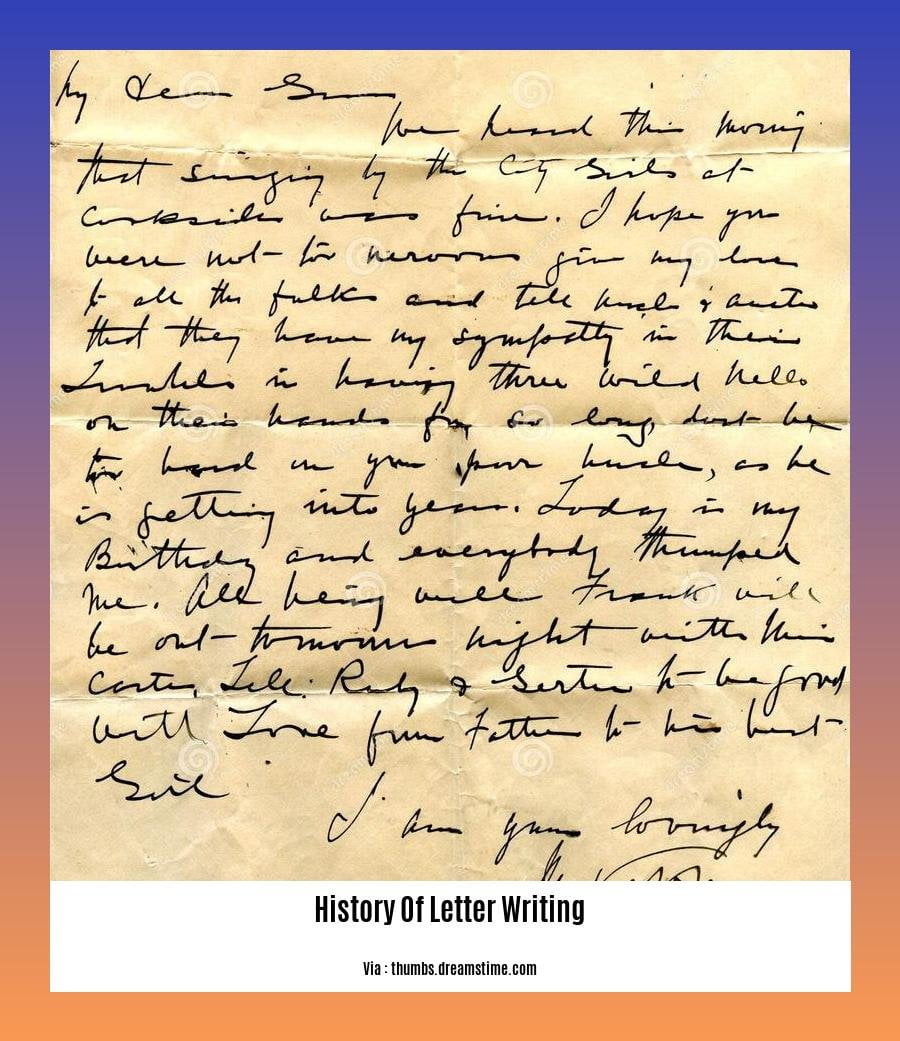Embark on an enthralling journey through the annals of human communication with [A Journey Through Time: Exploring the Rich History of Letter Writing]. Delve into the captivating evolution of this timeless art form, as we uncover the profound impact letters have had on shaping societies, fostering connections, and preserving our collective history.
Key Takeaways:

-
Letter writing has been a prevalent form of communication throughout history, tracing its roots back to ancient civilizations like India, Egypt, Sumer, Rome, Greece, and China.
-
In the 17th and 18th centuries, letters served multiple purposes, including self-education, sharing information, news, and greetings.
-
Love letters were a significant aspect of letter writing, exemplified by the correspondence between a nobleman and his sister in the 18th century.
-
The evolution of letter writing witnessed the transformation from ancient pictograms and hieroglyphs to the modern alphabet, influenced by the development of writing utensils and communication methods.
-
While the rise of electronic communication led to a decline in letter writing during the 20th century, it remains a crucial form of personal and professional communication in the present day.
History of Letter Writing
In the annals of human history, the written word stands as a testament to our enduring quest for connection, communication, and self-expression. Among these written treasures, letters hold a unique place, serving as intimate glimpses into the lives, thoughts, and emotions of people across time and cultures. Join us as we embark on a journey through the rich history of letter writing, uncovering the fascinating evolution of this timeless art form.
Ancient Origins:
The roots of letter writing can be traced back to the earliest civilizations, where pictograms and hieroglyphs served as a means of conveying information and recording events. In ancient India, the Indus Valley Civilization developed a complex script around 2500 BC, enabling written communication and record-keeping. Similarly, in ancient Egypt, the hieroglyphic script emerged as a sophisticated system of writing used for both monumental inscriptions and personal correspondence.
The Rise of Alphabetic Writing:
The development of alphabetic writing marked a turning point in the history of letter writing. Around 1500 BC, the Phoenicians introduced a simplified alphabet consisting of 22 letters, which laid the foundation for many modern alphabets. This innovation revolutionized communication, making it possible to represent sounds with individual symbols, enabling wider literacy and facilitating the exchange of letters.
The Flourishing of Letter Writing:
During the classical period, letter writing flourished in ancient Greece and Rome. Philosophers, poets, and statesmen exchanged letters that explored intellectual ideas, shared news, and conveyed personal sentiments. The letters of Cicero, Pliny the Younger, and Seneca offer invaluable insights into the lives and minds of these ancient luminaries.
The Art of Letter Writing:
In the Middle Ages, letter writing became a refined art form. Monks and scribes meticulously crafted letters using beautiful calligraphy and elaborate illuminations. Love letters, in particular, became a popular genre, expressing the deep emotions and desires of lovers separated by distance or circumstance. The letters of Héloïse and Abelard, two star-crossed lovers of the 12th century, remain a poignant example of this romantic tradition.
The Rise of Postal Systems:
The development of postal systems in the 16th and 17th centuries revolutionized letter writing. The establishment of regular postal routes enabled the reliable and timely delivery of letters, facilitating communication across vast distances and fostering closer connections between people.
The Modern Era:
The 20th century witnessed a significant decline in letter writing with the advent of electronic communication. The rise of the telephone, email, and instant messaging led to a shift away from handwritten letters. However, the art of letter writing persists today, valued for its personal touch and the enduring power of the written word.
Throughout history, letter writing has evolved in response to changing technologies, social norms, and cultural influences. From ancient pictograms to modern emails, letters have remained a vital means of communication, connecting people across time and distance. Whether expressing love, sharing news, or simply keeping in touch, letters offer a glimpse into the human experience and the enduring power of the written word.
Could anything ever capture the imaginations of young and old, past and present, better than the history of Lagoon, which has been an Intermountain icon for well over a century? If you are keen to find out more about the history of Lagoon Utah, then be sure to read on because it is a truly inspiring story. Are you passionate about the history of laundry? If so, then this amazing story will surely intrigue you.
Social and Cultural Impact: Examining the role of letters in shaping personal relationships, societal norms, and cultural exchange, reflecting the zeitgeist of different eras.

Letters, the timeless messengers of the human experience, have left an indecipherable imprint on the tapestry of our societies. Delving into the rich history of letter writing, we uncover its profound impact on personal relationships, societal norms, and cultural exchange.
Evolving Roles: From Personal Expression to Social Commentary
In the realm of personal relationships, letters served as cherished threads connecting hearts across distances. Whether it was lovers exchanging tender missives or families bridging oceans with news from home, letters carried the weight of emotions, longing, and shared experiences. In times of war, letters from the frontlines offered a lifeline of hope and connection, providing solace and strength to those left behind.
Beyond personal connections, letters have played a pivotal role in shaping societal norms and cultural exchange. In ancient Greece and Rome, letters were a vehicle for philosophical discourse, political debate, and the dissemination of knowledge. The epistles of Cicero and Seneca, for instance, not only shaped contemporary thought but continue to inspire and inform modern readers.
In the Middle Ages, letters served as instruments of diplomacy, alliance-building, and cultural exchange. The exchange of letters between rulers, merchants, and scholars facilitated the transfer of knowledge, ideas, and technologies across vast distances. The Silk Road, with its vibrant network of trade routes, played a crucial role in this cultural exchange, fostering understanding and cooperation among diverse civilizations.
Letters as Cultural Artifacts and Historical Reference
Letters, as cultural artifacts, offer a unique window into the past, providing invaluable insights into the zeitgeist of different eras. They capture the nuances of everyday life, from the mundane to the momentous, and reveal the hopes, fears, and aspirations of people from all walks of life.
Historians and researchers rely heavily on letters as primary sources, piecing together the intricate puzzle of the past. From the love letters of Henry VIII to Anne Boleyn to the war dispatches of Winston Churchill, letters provide a direct and often deeply personal account of history in the making.
Key Takeaways:
- 1- Letters played a vital role in forging and maintaining personal relationships across distances, providing a lifeline of connection and support.
- 2- Throughout history, letters have been instrumental in shaping societal norms, facilitating philosophical discourse, political debate, and the spread of knowledge.
- 3- Letters have acted as conduits of cultural exchange, fostering understanding and cooperation among diverse civilizations through the exchange of ideas, knowledge, and technologies.
- 5- As cultural artifacts, letters offer invaluable insights into the zeitgeist of different eras, capturing the nuances of everyday life and providing a glimpse into the hopes, fears, and aspirations of people from all walks of life.
- 6- Letters serve as primary sources for historians and researchers, providing a direct and often deeply personal account of historical events, shedding light on the past and enriching our understanding of history.
References:
– Letters and Social Change
– The History of Letter Writing
Technological Advancements: Highlighting the impact of technological innovations, from the invention of paper to the rise of postal systems, on the accessibility and efficiency of letter writing.
The evolution of letter writing has been profoundly shaped by technological advancements that have revolutionized the way we communicate over long distances.
The Invention of Paper
The invention of paper around 105 AD in China marked a pivotal moment in the history of letter writing. Before paper, people communicated using various materials such as papyrus, parchment, and wax tablets, all of which were expensive and cumbersome to use. The introduction of paper, made from plant fibers, provided a more affordable and versatile medium for writing, making it accessible to a wider population.
The Rise of Postal Systems
The development of postal systems was another crucial technological innovation that facilitated the efficient delivery of letters. In the early 16th century, the first modern postal system was established in France, and by the 19th century, postal systems had spread throughout the world. These systems enabled letters to be sent and received over long distances in a reliable and timely manner, fostering communication between individuals, businesses, and governments.
The Impact of Technology on Letter Writing
The technological advancements in papermaking and postal systems had a profound impact on the accessibility and efficiency of letter writing:
- Increased Accessibility: The affordability and availability of paper made letter writing accessible to a wider range of people, including those from lower socioeconomic backgrounds.
- Improved Efficiency: Postal systems allowed letters to be delivered more quickly and reliably, enabling faster communication and response times.
- Expanded Communication: The combination of paper and postal systems facilitated long-distance communication, connecting people across vast distances and fostering global交流。
Key Takeaways:
- The invention of paper provided a more affordable and versatile medium for writing, making it accessible to a wider population.
- The rise of postal systems enabled letters to be sent and received over long distances in a reliable and timely manner.
- Technological advancements in papermaking and postal systems increased the accessibility, efficiency, and reach of letter writing, fostering communication and global connections.
Citations:
Papermaking in China
History of the Postal System
**Contemporary Significance: Discussing the enduring relevance of letter writing in the digital age, exploring its power to convey intimacy, authenticity, and personal touch in a world dominated by electronic communication.**
In this era of instant messaging and social media, the art of letter writing might seem like a relic of the past. But I’m here to tell you that letter writing is alive and well—and more relevant than ever.
Despite the dominance of electronic communication, letter writing endures as a powerful means of conveying intimacy, authenticity, and a personal touch. In this digital age, a handwritten letter stands out as a tangible reminder of human connection, evoking a sense of nostalgia and intimacy.
Embracing Empathy in a World of Swift Exchanges
In an era characterized by fleeting interactions, letter writing invites us to slow down, embrace empathy, and immerse ourselves in the emotions and experiences of another. Through carefully crafted words and thoughtful expressions, letters allow us to connect with others on a deeper level, fostering meaningful relationships and fostering a sense of community.
The Power of Permanence in a Transient World
In a world where digital messages vanish into the cyber void, letters offer a tangible and enduring form of communication. They serve as a physical reminder of our connections, carrying the weight of our thoughts and emotions. Letters can be revisited, cherished, and passed down through generations, becoming貴重な heirlooms that bridge the gap between past and present.
Key Takeaways:
- In the era of instant messaging and social media, letter writing endures as a means of conveying intimacy, authenticity, and a personal touch.
- Letters stand out as tangible reminders of human connection, evoking nostalgia and intimacy in a digital age.
- The act of letter writing fosters empathy, inviting us to slow down and immerse ourselves in the emotions and experiences of another.
- Letters offer a sense of permanence in a transient world, serving as cherished heirlooms that can be revisited and passed down.
Relevant URL Sources:
- https://www.parentcircle.com/why-writing-letters-is-still-important-today/
FAQ
Q1: What significant role did letter writing play in ancient civilizations?
A1: In ancient civilizations, letter writing served as a primary means of communication, enabling the exchange of information, news, and greetings. It played a crucial role in facilitating trade, diplomacy, and cultural exchange between distant regions.
Q2: How did letter writing contribute to the development of self-education during the 17th and 18th centuries?
A2: During the 17th and 18th centuries, letter writing served as a tool for self-education and personal growth. Individuals engaged in letter writing to share knowledge, discuss ideas, and seek advice from distant mentors and peers. This practice fostered intellectual growth and the exchange of diverse perspectives.
Q3: What was the significance of love letters in the 18th century?
A3: Love letters played a significant role in the 18th century as a means of expressing emotions and maintaining long-distance relationships. They allowed individuals to convey their feelings, share intimate thoughts, and strengthen their emotional bonds, despite physical distance.
Q4: How have writing materials and communication methods influenced the evolution of letter writing over time?
A4: The evolution of letter writing has been closely tied to the development of writing materials and communication methods. From ancient pictograms and hieroglyphs to the modern alphabet, the choice of writing utensils and the emergence of faster communication technologies, such as postal services and electronic mail, have shaped the form and style of letters throughout history.
Q5: What are some of the factors that contributed to the decline of letter writing in the 20th century?
A5: The decline of letter writing in the 20th century can be attributed to several factors, including the rise of electronic communication technologies, such as the telephone and email, which offered faster and more convenient alternatives for personal and professional communication. Additionally, changes in social norms and the increasing pace of life contributed to the shift away from traditional letter writing.
- Unveiling the Enigma: Mansoureh Khojasteh Bagherzadeh’s Public Appearances & Private Life in Iran - July 18, 2025
- Unveiling the Mystery: Mansoureh Khojasteh Bagherzadeh’s Husband: A Rare Glimpse into a Private Life - July 18, 2025
- Unveiling Masoud Khamenei’s Mother: Power, Influence, and Iran’s Future - July 18, 2025
















